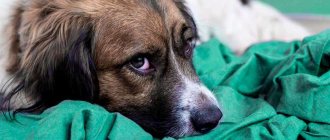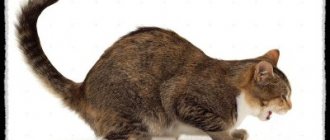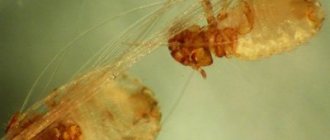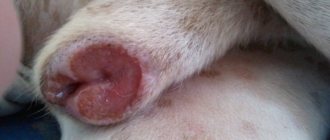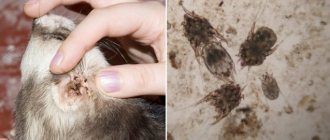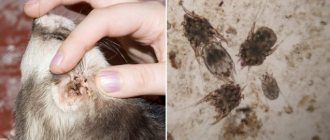Not every breeder of furry pets knows that distemper occurs in cats. This common viral disease occurs not only among dogs, as many of us are accustomed to believe. In most cases, feline panleukopenia (this is the official name for this disease) ends tragically for the pet.
Features of the disease
Discharge from the nostrils and eyes is one of the signs of distemper in cats.
Feline distemper, or panleukopenia, is a highly contagious disease. The clinical picture depends on the type of disease, but always manifests itself with fairly clear signs. This is due to the rapid multiplication of the virus in the body, the speed of which largely depends on the state of the immune system. The most vulnerable felines are kittens, pregnant and weakened cats, as well as purebred pets.
The virus that causes distemper in domestic cats is highly resistant to external factors. It can tolerate low and high temperatures; even heating to +60 ˚C can destroy it only after 60 minutes. Disinfectants also cannot destroy pathogenic microorganisms, especially if they are diluted in low concentrations.
Read also
Urolithiasis in cats
Urolithiasis is a disease accompanied by the formation and deposition of urinary stones or sand
How to choose cat food?
Nowadays, from all the variety of cat food, it is very difficult to choose high-quality food that is suitable and will not harm your pet.
Cystitis in a cat. Symptoms and treatment
Cystitis is an inflammation of the bladder. It is a disease of the genitourinary system that occurs not only in humans, but also in animals.
Ear mites in cats: signs and treatment
The appearance of a parasite such as ear mites in a cat is the beginning of a serious disease that must be eradicated at the first symptoms.
Worms in cats: symptoms, signs and treatment
The first signs of infection may be absent for some time or resemble manifestations of other diseases
How can a cat become infected with distemper?
There are several ways a cat can become infected with the distemper virus. In each of them, the source is the biological secretions of an already sick animal or a carrier of infection.
Infection method
Detailed description
Direct contact
A pet can “catch” the disease by directly touching objects that the sick animal has come into contact with. The virus can enter the house and on the owner’s belongings.
Oral route
Distemper infection will also occur if you eat food or drink that contains the infection.
Through the air
If a healthy cat is in the same room as an infected one, then panleukopenia cannot be avoided.
Through bites
Blood-sucking insects are capable of transmitting the feline distemper virus.
In utero
The feline distemper virus is able to cross the placental barrier. In most cases, fetuses die before birth. If the kittens succeed in being born, then in the near future (no more than two days) they still die.
Many owners are interested in whether a cat can get distemper from a dog? No, he can not. The viruses that cause plague in these animals are completely different.
Causes of ingrown toenails
An ingrown toenail can result from:
- Congenital or acquired structural features of the foot and fingers that contribute to the development of onychocryptosis, such as flat feet, deformation of the fingers and others.
- Wearing narrow shoes that press the periungual fold into the nail plate.
- Wearing high-heeled shoes, in which the feet are inclined and the main pressure is on the toes.
- Fungal diseases of nails.
- Wearing a cast or a very tight bandage for a long time.
- Foot injuries.
- Improper trimming of nails, cutting them too deep, cutting off the corners of the nails too much, or leaving a hangnail.
- Diabetes.
- Gout.
Other factors or a combination of them also lead to onychocryptosis. Excess weight, poor posture, untimely and improper foot hygiene, pregnancy, injuries and various diseases can affect the development of an ingrown toenail.
How does distemper manifest in cats?
The feline distemper virus can infect almost all organ systems: nervous, respiratory, cardiovascular, and digestive tract. Symptoms of the disease depend on which organs the microorganism has managed to damage, on the capabilities of the cat’s immune defense, as well as on the form of the disease, which can be of three types.
Form of the disease
Peculiarities
Symptoms
Lightning fast
It has a particularly high mortality rate as it develops quickly. It is observed mainly in kittens of the first year of life. The smaller the kitten, the faster it dies. The fulminant form is often manifested by disorders of the nervous and digestive systems.
- Refusal to suck, food, water
- Apathetic state
- Avoiding bright light and sharp sounds (when they occur, it begins to squeak loudly)
- Diarrhea, vomiting
- Tousled fur
- Body tremors, convulsions
- Paralysis
Acute
More common in adult cats. The incubation period ranges from 3 to 10-14 days. The clinical picture is varied and depends on the number of affected organs. Mainly the gastrointestinal tract, respiratory system, and heart are affected. With timely contact with specialists and proper treatment, the pet can recover. If no help is provided to the animal in the next 3-5 days after the onset of symptoms, it will die.
- Apathy
- Temperature rises to 41˚
- Vomit contains blood, mucus, and foam
- Despite being thirsty, the cat refuses to drink water
- Skin spots
- Cough, wheezing
- Discharge from nostrils, eyes
- Tachycardia
- Shortness of breath, mouth breathing
- Sunken eyes, tousled, dull coat
Subacute
It is typical for adult mustachioed individuals and cats that have been vaccinated against distemper. The disease may last for 1-3 weeks.
The same as in the acute form of plague, but in a less pronounced form.
Prognosis and consequences for panleukopenia
Carnivorous plague is most dangerous for kittens, although an adult animal also has a risk of dying. Statistics indicate the following percentage projections:
- without treatment, mortality in infants under one year of age tends to 100%;
- in kittens that are less than two months old, as well as in weakened fluffies up to six months, even if the disease is treated correctly, the probability of survival is no more than 5-10%;
- healthy, strong babies from 2 to 6 months have a 30-40% survival rate;
- adult animals receiving proper treatment, preferably in a hospital, vaccinated, as well as those in which the disease occurs in acute and subacute forms, have a 90-95% survival rate;
- In adults, the survival rate is about 70% with proper treatment, and about 10% without treatment.
Most animals acquire immunity to panleukopenia. For the majority of those who are cured, the disease passes without a trace, but for some, reminders of the disease remain in the form of gastrointestinal disorders, respiratory and cardiovascular disorders, and neurological manifestations. These pets need special care and dietary nutrition.
Therapeutic measures
At the first symptoms of distemper, we recommend immediately contacting a veterinarian
Treatment of distemper in cats includes several tasks: destroy the virus, eliminate intoxication, prevent secondary infection, increase immunity, and so on. To combat the virus, drugs such as Vitafel, Fosprenil, Enterostat are used. The administration regimen is prescribed by the veterinarian.
Various drugs are used as a symptomatic treatment for distemper in cats.
- Sodium chloride. The distemper virus causes severe dehydration and intoxication. The body cannot cope with toxins on its own. Intravenous administration of a chloride solution helps restore the balance of water, salts, and minerals.
- As a rule, distemper in cats is accompanied by a secondary infection. To eliminate it, the veterinarian will prescribe antibacterial agents.
- Diuretic fees. To quickly cope with toxic metabolic products and remove them from tissues and the body, decoctions of diuretic herbs and herbs are used. In frequent small portions, you can give your cat a decoction of lingonberries, horsetail, bearberry leaf and others.
- If there is no vomiting, it is recommended to use Regidron or Ringer's solution to normalize the water-mineral balance. The daily amount of solution is calculated based on the ratio of 5 tbsp. l. liquid per 1 kg of animal weight. You can add glucose solution and sodium bicarbonate to the diluted drugs (the proportions must be checked with your veterinarian).
- For pain and spasms in the digestive tract, taking antispasmodics, for example, No-shpa, is indicated.
- Catozal will help strengthen metabolic processes, improve immunity, and stimulate the body to recover. It must be administered within 7 days.
- The treatment complex also includes vitamin supplements, especially antioxidants A and C, and B vitamins. It is advisable to combine their intake with drugs containing iron, for example, Ferrodextran.
Home care
Proper care at home for a cat with distemper increases the likelihood of a successful recovery. If possible, it is better to give injections by calling a doctor at home, since any stress can negatively affect the animal’s condition. If you have to visit the clinic every day, then for transportation it is better to build a basket yourself (for example, from a cardboard box), so that you can burn it later.
The room where the cat is located should be warm and dry, without draft wind. Since the virus also affects the nervous system, you need to provide your pet with peace and shade with bright light.
You can drink both plain water (boiled) and decoctions of medicinal herbs. Their choice should be previously agreed with your veterinarian, because some medications and plant extracts may be incompatible. You need to feed your pet little by little, at the beginning of treatment - only broths, gradually adding porridge and chopped meat to them. It is recommended to follow a diet until complete recovery.
In agreement with the doctor, it is allowed to give the cat enemas. They may include herbal preparations, decoctions, and antiseptics. The tray and bowls should be placed next to the animal, and the bedding should be changed daily. Washing your pet while sick is not recommended.
Diagnosis and treatment
Since the symptoms coincide with many other diseases, such as poisoning, pancreatitis, leukemia and some others, for an accurate determination you need to go to the veterinary clinic. The sooner a diagnosis is made, the greater the chances of a cure for your mustachioed friend. If your cat has been vaccinated, take your veterinary passport with you.
Establishing a diagnosis in a veterinary clinic
The final diagnosis is made based on a combination of examination and tests. The PCR method works quite accurately for vaccinated individuals: for this, the feces are examined for the presence of infected particles in it.
If the animal is not vaccinated, then a general blood test is taken. The most important indicator for a doctor is leukocytes. If their number is greatly reduced, this indicates infection with panleukopenia. Taking into account the data obtained, the specialist makes an accurate diagnosis.
Medicines prescribed by a doctor
It is best to place your furry friend in a hospital, if possible. It is more expensive, but the chances of “getting out” the patient are much greater. Often, against the background of plague, sick cats experience anemia. In a clinical setting, you can give a blood or plasma transfusion.
The main treatment goals look like this:
- Rehydration solutions
. Since the main threat is dehydration, the main thing in treatment is to maintain the body’s water and electrolyte balance, and this is most effectively done with the help of droppers. Clinics have equipment to monitor blood electrolyte levels. For the fastest fluid replenishment, a central catheter is placed in the jugular vein in the neck, but it can also be placed in the paw. Subcutaneous administration of solutions is not as effective, but even this method is better than drinking it by mouth, since the liquid does not have time to be absorbed, and such therapy is of no use.
- Antibiotics
. In a cat, distemper kills the entire immune system, and bacteria from the intestines attack the body. Therefore, the use of antibiotics is always mandatory. The most effective combination of two drugs, one of which kills gram-positive bacteria, and the other kills gram-negative bacteria. Antibiotics are given intravenously into the same catheter. Combinations of metronidazole and cephalosporins or sumamed work well.
- Serums, immunoglobulins
. The use of ready-made antibodies against the virus is effective in the initial stage of the disease, but if the picture is already developed, their use does not make much sense. But you can use them to reassure yourself, to make sure you did everything you could. Veterinary publications comment that these drugs have class 4 evidence and are presumably effective.
- Immune stimulants
. They are not used anywhere except in the CIS countries, and are not recognized as evidence-based medicine, since they do not have any convincing research results. Therefore, they are not the main purpose, but many veterinarians use them.
- Emetic suppressants
. With vomiting, the tailed patient loses precious fluid, so it is imperative to suppress vomiting. These are medications containing metoclopramide (Cerucal and others). They are given at the rate of 0.1 ml per kg of weight. H2-histamine receptor blockers, such as Ranitidine, Zantac and others at the same dosage, have a successful effect.
- Painkillers, antipyretics
. These drugs are best given in veterinary clinics. It is not advisable to give analgin. High fever can be reduced with conventional medications.
- Parenteral nutrition
. Often a sick animal does not eat on its own, so it is necessary to organize intravenous administration of carbohydrate-, fat-, and amino acid-containing solutions. In their absence, at least glucose and isotonic multivitamin preparations should be administered.
Often there is no possibility of placement in a clinic, and owners are forced to treat cats at home. In this case, it is necessary to install a catheter - an IV gives a huge chance of recovery. If installation of a catheter is impossible for various reasons, regular administration of solutions should be done subcutaneously. This is the most important point in the entire treatment.
Caring for a sick animal
If a kitten has distemper, the best care is provided in a hospital. At home, maintenance occurs as follows:
:
- the pet is given a room in which no one will disturb or disturb him;
- remove feces in a timely manner;
- ventilate the room and perform wet cleaning;
- carry out therapeutic measures prescribed by a veterinarian;
- for conjunctivitis, treat the eyes.
Disinfection of the premises is very important. It is better to burn beds and toys or throw them away in a tightly tied bag. To reduce the number of viruses, you need to quartzize your apartment. Floors and surfaces are washed with a disinfectant; Laina or Virkon can be used. In extreme cases, Domestos or Javel water will do. Alkalis are effective, but dangerous.
Peracetic acid solutions are good to use in the room where moustached patients live. You can treat bowls and trays with them, as the solution quickly decomposes to harmless acetic acid.
Gentle diet
If the cat does not want to eat or drink, there is no need to force it. When a recovering purr's appetite awakens, you need to give him easily digestible, tasty food enriched with vitamin B. It should be warm. A list of permitted products or medicinal food will be prescribed by your veterinarian.
It is better to feed both kittens and adults in small portions 5-6 times a day - this will make it easier for the gastrointestinal tract to cope with food. After a few days, you can introduce boiled, chopped lean meat, poultry and fish. You can load your stomach with raw food no earlier than 2-3 months after complete recovery.
Can other animals or humans become infected with feline distemper?
Is a pet with panleukopenia dangerous to others? Cats after distemper are carriers of the virus for 4-5 months and can become its source, but only a feline can become infected. The mustachioed friend poses no danger to surrounding people and pets.
The virus, which is carried by a recovered cat, is released into the external environment with biological fluids, so throughout the entire period of carriage the pet should not be allowed to leave the house. The cat itself acquires immunity to the plague for a long period, sometimes until the end of its life.
Risk group
It includes all unvaccinated pets, but some of them also have weak immunity:
- Kittens under 1 year of age.
- Elderly animals.
- Pregnant cats.
- Cats with chronic diseases and allergies.
- Representatives of selected breeds: Maine Coons, Siamese, British and Persian cats.
Prevention of plague
Don’t forget about vaccination, and the risk of getting distemper will be minimized
The most effective preventative measure for feline distemper is vaccination. Since there are currently enough vaccines, the doctor chooses at his own discretion. The following drugs are popular: Nobivak, Multifel, Feleniffa.
Kittens are first vaccinated at 1.5-2 months, and after 3-4 weeks they are revaccinated. Subsequently, the vaccine is administered once a year.
You can prevent a deadly disease by not letting newborn kittens go outside, preventing your pets from escaping and interacting with unfamiliar family members. In addition, it is necessary to monitor the immune system of your mustachioed friend, providing the cat with adequate nutrition and vitamins.
